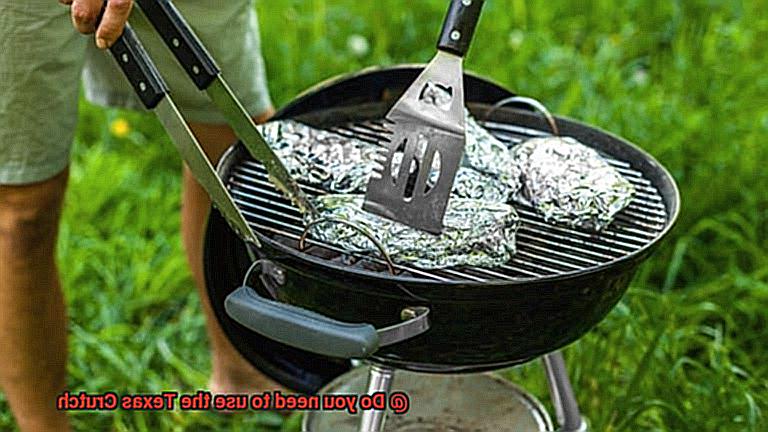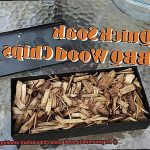If you’re a barbecue aficionado, then you’ve likely heard of the “Texas Crutch.” It’s a smoking technique that’s meant to speed up cooking times and guarantee juicy, tender meat. But is it really necessary? And what exactly is the Texas Crutch?
Well, my friends, let me enlighten you on this smoky topic. The Texas Crutch involves wrapping your meat in foil or butcher paper to trap in moisture and reduce cook time. This method can be particularly useful for meats like brisket that need 12-15 hours of smoking.
But here’s the catch: Some people argue that using the Texas Crutch takes away from the authentic smoking process and results in less flavorful meat. So, is it worth it to use the crutch? Ultimately, it depends on your personal preference and smoking experience.
In this blog post, we’ll explore both sides of the debate and provide tips for mastering the Texas Crutch technique. Whether you’re a seasoned pitmaster or just starting out with backyard BBQs, understanding this method will take your smoking game to new heights.
So, are you ready to learn everything there is to know about the Texas Crutch? Let’s fire up those smokers and get started.
Contents
What is the Texas Crutch?
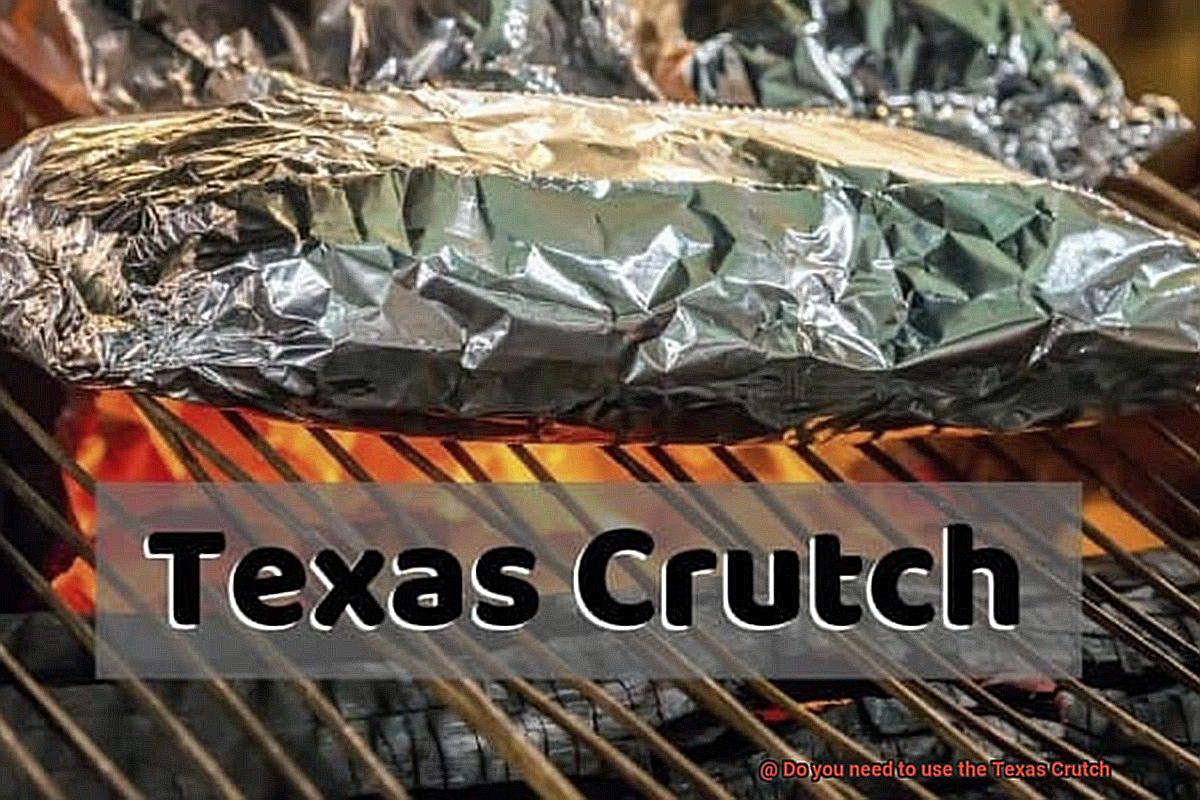
This popular technique is used by pitmasters in Texas-style BBQ to create tender, moist meat. But what exactly is the Texas Crutch, and should you be using it in your BBQ cooking?
The Texas Crutch involves wrapping the meat in foil or butcher paper during the cooking process to create a steaming effect and trap moisture. This technique is especially useful for tougher cuts of meat like brisket, which can take hours to cook. The term “Texas Crutch” was coined by BBQ expert Meathead Goldwyn after noticing it being used in Texas BBQ competitions.
But while some pitmasters swear by the Texas Crutch, others argue that it can result in steamed rather than smoked meat, affecting the flavor profile. Additionally, using the crutch can hinder the development of a good bark and result in a softer texture. So, whether or not to use the Texas Crutch is up to personal preference and the desired outcome for the meat being cooked.
For those new to smoking or cooking tougher cuts of meat, using the Texas Crutch can be a useful technique to keep your meat moist and tender. However, if you prefer a traditional smoky flavor and texture, you may want to skip the crutch and stick with a longer, slower cook time.
It’s important to note that some competition BBQ rules prohibit the use of foil or paper during cooking. If you plan on entering any competitions, you’ll need to learn how to cook without the crutch.
Benefits of Using the Texas Crutch
Firstly, the Texas Crutch can significantly reduce cooking time. The process of wrapping the brisket in foil or butcher paper allows it to steam in its own juices, resulting in faster breakdown of tough connective tissues. This means that you can achieve the perfect texture in a shorter amount of time, without sacrificing flavor or tenderness.
Another advantage of using the Texas Crutch is that it creates a more consistent result. When cooking brisket without wrapping, certain parts of the meat can become dry or overcooked, ruining the overall experience. Wrapping the brisket ensures that every part of it is cooked evenly and thoroughly, resulting in a delicious and perfectly cooked brisket every time.
But that’s not all – using the Texas Crutch also helps to keep your brisket warm and moist for longer periods of time. Once the cooking process is complete, you can leave it wrapped in foil or butcher paper for several hours without worrying about it drying out. This makes it perfect for serving at events where you need to keep food warm over an extended period, such as weddings or large parties.
Drawbacks of Using the Texas Crutch
While the Texas Crutch may seem like a tempting shortcut, it’s important to consider the drawbacks before wrapping up your next cook.
One of the primary concerns with using the Texas Crutch is the potential loss of bark or crust on the meat. The bark is the flavorful and caramelized outer layer that forms during smoking and gives the meat its signature taste. Wrapping the meat in foil or butcher paper can cause steam to build up and soften the bark, resulting in a less desirable texture and flavor.
Another issue with using the Texas Crutch is overcooked or mushy meat if not done correctly. The goal of this technique is to soften tough cuts of meat by steaming them in their own juices. However, leaving the meat wrapped for too long can result in a loss of texture.
In addition to these drawbacks, some purists argue that using the Texas Crutch goes against traditional BBQ methods and takes away from the authenticity of slow cooking over low heat. They believe that BBQ should be cooked without shortcuts or techniques like the crutch.
So, before using this method, it’s essential to weigh the pros and cons and determine if it aligns with your personal preferences and goals for BBQ cooking. If you are looking for a quick fix and don’t mind sacrificing some bark or texture, then give it a try. However, if you value tradition and authenticity in your BBQ cooking, then skip the crutch and stick to your tried-and-true methods.
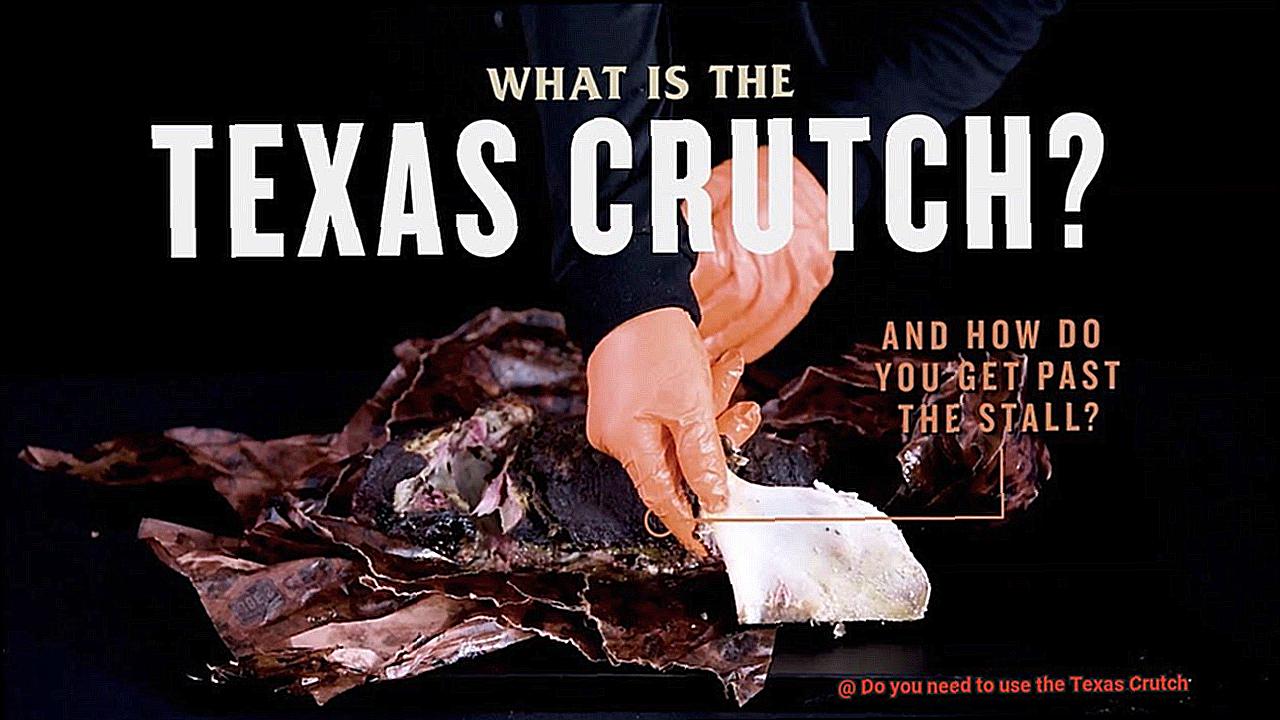
Types of Meats Best Suited for the Texas Crutch
When it comes to making mouth-watering smoked meats, the Texas Crutch is a popular technique used by pitmasters. This method involves wrapping the meat in foil or butcher paper during the cooking process to trap in moisture and heat, resulting in tender and juicy meat. However, not all meats are created equal when it comes to the Texas Crutch. Let’s take a closer look at which types of meats are best suited for this technique.
Beef Brisket:
If you’re a fan of brisket, then the Texas Crutch is your go-to technique. Brisket is a tough cut of meat that requires low and slow cooking to achieve a tender result. The Texas Crutch helps to speed up the cooking process and ensures that the brisket stays moist during the long cook time. By wrapping brisket in foil or butcher paper, you’ll get a tender and juicy result with a delicious smoky flavor.
Pork Shoulder:
Pork shoulder is another meat that benefits from the Texas Crutch. Like brisket, pork shoulder is a tough cut of meat that requires a long cooking time to become tender. Using the Texas Crutch helps to speed up the cooking process and ensures that the pork shoulder stays moist throughout the cook time. The result is succulent and flavorful pulled pork that falls apart with ease.
Ribs:
While ribs don’t necessarily need the crutch, using it can help to ensure that they stay moist and tender during the cooking process. However, it’s important to note that some pitmasters prefer not to use the Texas Crutch on ribs, as it can result in a softer texture and less bark formation. If you prefer a firmer texture with more bark, skip the crutch for your ribs.
Chicken and Fish:
Meats like chicken and fish are not typically cooked using the Texas Crutch. These meats are more delicate and cook quickly, so using the crutch could result in overcooked or mushy meat. To get the best results, stick to a traditional smoking method for these meats.
Alternatives to the Texas Crutch
Smoking meat is an art form that requires patience, skill, and a bit of creativity. While the Texas Crutch is a popular technique among pitmasters, it’s not the only way to achieve delicious, succulent meat. In fact, there are several alternatives that can produce mouth-watering results that are worth exploring.
One such alternative is spritzing. This method involves spraying your meat with a liquid during the smoking process. The liquid can be water, apple juice, beer, or any other flavorful liquid that complements the meat. Spritzing helps to keep the meat moist while adding an extra layer of flavor that will leave your taste buds dancing.
Another option is to wrap the meat in foil or butcher paper instead of using the Texas Crutch. Foil wrapping can help to retain moisture and speed up cooking time, while butcher paper allows for some air circulation which helps to retain the bark. For those who can’t decide between the two, combining both methods by wrapping the meat in foil first and then switching to butcher paper towards the end of the cooking process can provide a winning combination.
If you’re willing to wait a bit longer for your meat to cook, low and slow cooking is another excellent alternative. This method involves cooking the meat at a lower temperature for a longer period of time. The natural juices in the meat break down slowly over time resulting in a tender and juicy final product that will make all your hard work worthwhile.
Factors to Consider When Deciding Whether or Not to Use the Texas Crutch
As a pitmaster, you understand that choosing the right cooking method can make all the difference in achieving the perfect texture, flavor, and tenderness. One popular technique you may have heard of is the Texas Crutch, which involves wrapping meat in foil or butcher paper to keep it moist and speed up cooking time. But before you decide to use the Texas Crutch on your next cook, there are some crucial factors to consider.
First and foremost, the type of meat being cooked is a critical factor in determining whether or not to use this technique. For instance, brisket and pork shoulder benefit significantly from the Texas Crutch, while ribs and chicken may not need it. Knowing the unique characteristics of each type of meat will help you make an informed decision.
Another crucial factor to ponder is the desired level of bark on the meat. The Texas Crutch can soften or even eliminate the outer bark on the meat, which may not be ideal for those who crave a crispy bark. If you’re looking for that perfect crunch, then skipping the Texas Crutch might be your best bet.
Time is also a vital consideration when using the Texas Crutch. If you’re short on time and need your meat cooked quickly, then this technique can significantly reduce cooking time. On the other hand, if you have plenty of time to let your meat cook slowly and naturally without any intervention, then foregoing the Texas Crutch may be more suitable.
Finally, personal preference should always be taken into account when deciding whether or not to use the Texas Crutch. Some pitmasters swear by this technique and use it for every cook, while others prefer to let their meat cook naturally without any intervention. Ultimately, it’s all about what works best for your style and taste.
Competition BBQ Rules Regarding Foil/Paper Wrapping
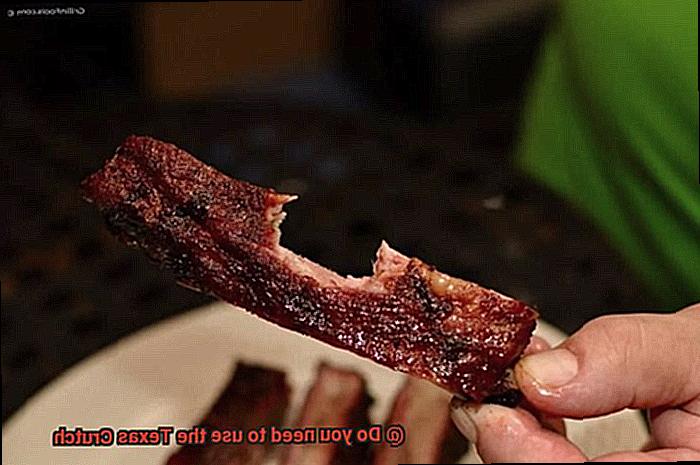
Competition BBQ is a serious business, and there are strict rules and regulations to be followed. One of the most debated topics in this world is the use of foil or paper wrapping, also known as the Texas Crutch. The rules regarding its use vary depending on the specific competition, and it’s essential to thoroughly read and understand them before entering a competition to avoid disqualification.
For competitions that allow the use of foil or paper wrapping, there are still restrictions in place. Certain types of foil or paper may be allowed while others may not. Additionally, the amount of wrapping used during the cooking process may be limited.
The use of the Texas Crutch is a controversial topic among BBQ enthusiasts. Some argue that it takes away from the true flavor and texture of the meat, while others swear by its effectiveness in creating tender and juicy meat. Ultimately, it’s up to personal preference and following the specific rules set forth by competition organizers.
When it comes to choosing the right cooking method, sticking to guidelines is essential. However, there are additional factors to consider when competing in BBQ competitions. Here are some subtopics to keep in mind when it comes to using foil or paper wrapping in competition BBQ:
- Understanding the rules: As mentioned before, each competition has its own set of rules and regulations regarding foil or paper wrapping. It’s important to read and understand these guidelines before entering a competition.
- Types of foil or paper: If a competition allows wrapping, they may specify which types are allowed. It’s crucial to follow these guidelines as using non-approved materials can lead to disqualification.
- Limits on usage: Even if a competition allows for wrapping, they may limit how much can be used during the cooking process. It’s important to adhere to these limits to avoid disqualification.
- The controversy surrounding the Texas Crutch: Many BBQ enthusiasts have strong opinions about using foil or paper wrapping in competitions. While some swear by it, others argue that it takes away from the true flavor and texture of the meat. It’s important to consider these opinions when deciding whether to use the Texas Crutch in competition BBQ.
Tips for Successfully Using the Texas Crutch
Smoking meat is not only a cooking technique, but also an art that requires patience, skill, and proper technique. One popular technique used by pitmasters to create moist and tender meat is the Texas Crutch. However, it’s important to follow some tips to ensure success and avoid negative impacts on the flavor and texture of the meat.
Equipment Matters
To use the Texas Crutch, it’s crucial to have the right equipment, such as heavy-duty aluminum foil or butcher paper and a probe thermometer. You’ll also need a good quality smoker or grill with proper temperature control and ventilation.
Timing is Key
Before wrapping your meat, make sure it has reached the desired level of smokiness and bark formation. Wrapping too early can lead to a lack of flavor and texture.
Seal Tightly
Once you wrap the meat, seal the edges tightly to prevent any steam from escaping. This will help create a moist environment inside the foil or paper which will allow the meat to cook more evenly and stay tender.
Add Some Liquid
Adding liquid like apple juice or beer to the foil before sealing it can add flavor to the meat and keep it moist throughout the cooking process.
Be Patient
While using the Texas Crutch can help speed up the cooking time, it’s still important to cook the meat low and slow to ensure that it’s tender and flavorful. Proper planning and giving yourself enough time for the meat to cook properly are essential.
7msjfbrHAU4″ >
Conclusion
To wrap or not to wrap? That is the question when it comes to the Texas Crutch smoking technique. Wrapping meat in foil or butcher paper can speed up cooking time and keep it moist, but some argue that it takes away from the authentic smoking process and results in less flavorful meat.
So, do you need to use the Texas Crutch? The answer is purely subjective and depends on your desired outcome for the meat being cooked. It’s important to weigh the pros and cons before deciding if this technique aligns with your BBQ cooking goals. Plus, competition BBQ rules may prohibit its use during cooking, so make sure you understand these guidelines before entering any competitions.
If you do decide to try out the Texas Crutch, there are tips for success such as using proper equipment, timing, sealing tightly, adding liquid, and being patient. However, there are other techniques like spritzing or low and slow cooking that can produce mouth-watering results without using the crutch.
In summary, understanding the Texas Crutch technique will take your smoking game to new heights. But ultimately, it’s up to you as a pitmaster to decide if it’s worth incorporating into your BBQ cooking style. So experiment with different methods and find what works best for you and your taste buds.

